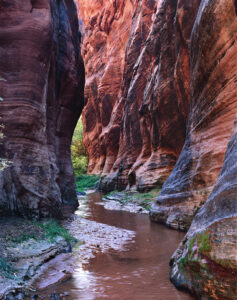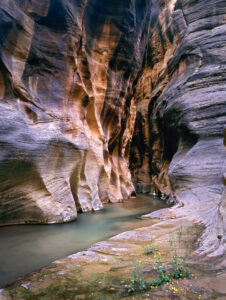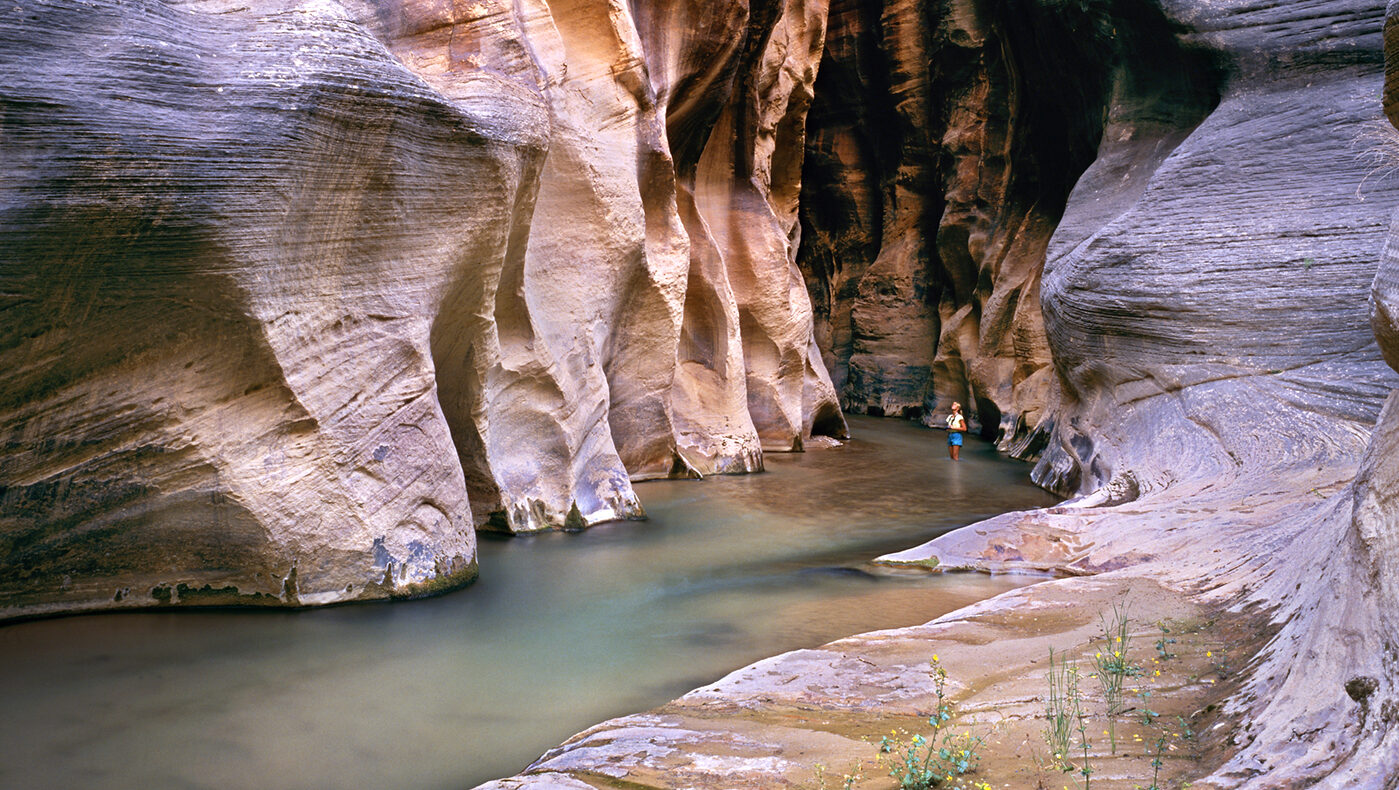The Washington County Water Conservancy District (WCWCD) is joining the Kane County Water Conservancy District (KCWCD) to divert water from the tiny East Fork of the Virgin to build the Cove Reservoir

East Fork of the Virgin. Photo by David Petit
About the Project:
The East Fork of the Virgin flows through Orderville and joins the main channel of the Virgin River in Springdale. According to the Washington and Kane County water districts, the purpose of the Cove Reservoir Project is to improve the ability of farmers to utilize their full water rights to irrigate fields, primarily alfalfa fields, in the respective counties.
The proposed Cove Reservoir site is over a mile from the point of diversion and situated at a higher elevation. Power would be required to pump the water from the point of diversion on the East Fork to the reservoir site. Here is a map detailing the location of the project.
CSU’s Perspective:
The East Fork of the Virgin River is a small stream of critical significance. Conserve Southwest Utah (CSU) is concerned that the Cove Reservoir would permanently change the river’s natural flow and disrupt this already fragile riparian ecosystem. In the face of rapid climate change, in megadrought conditions, the project would cause and greatly exacerbate changes in the timing, amount, and natural flow of the river that would negatively impact the plants, fish, wildlife, and interconnected ecosystems they depend on to survive.
The East Fork of the Virgin River is designated as Wild under the Wild and Scenic Rivers Act, where it flows through Zion National Park. The project will likely alter water flows in this area, and changes in flow rates will likely affect the wild qualities of the river.
The change in the natural flow patterns in the summer may also negatively impact the famous slot canyons of the Bureau of Land Management’s Parunuweap Canyon Wilderness Area (WSA) of 30,800 acres. The WSA boundary is near the project area along the East Fork and downstream of the gravel pits needed to build the 90-foot-high earthen dam. The East Fork runs through the proposed wilderness area—an area that should remain wild.

East Fork of the Virgin. Photo by David Petit
How would the proposed Cove Reservoir be funded?
The water districts plan to finance the project with funds from the National Resource Conservation Service (NRCS) which is a program administered through the USDA to assist farmers. The grant would cover the majority of the construction costs with each water district having to contribute an unspecified amount but expected to be in the millions for each district.
What is happening right now?
To move forward the sponsoring water districts must prepare an Environmental Impact Statement (EIS). Currently, the ‘scope of work‘ for the EIS is being reviewed by the public and comments are being accepted until April 28, 2022.
CSU’s water advocacy team is submitting an extensive substantive commenting document seeking to influence the scope of work that the NRCS will use in developing the draft Environmental Impact Statement.
We are going to the mat on this one and will need your support every step of the way!
Please consider entering a public comment about the scoping for the EIS. Below are the instructions on how to comment along with a few suggestions. Comments should focus on the elements of this project that must be analyzed and evaluated in its EIS.
Once the scoping is finalized, the agency will prepare a draft Environmental Impact Statement which the public will have an opportunity to review. We will keep you informed of how you can continue to register your concerns.
Steps for submitting a comment:
Here are some resources to review that could be helpful before writing your comment:
- From the Federal Register the Notice of Intent. This document describes the proposed Cove Reservoir Project.
- Additional information on the NRCS Project website.
News articles offering background information on the project:
- Kane County looking to dam the Virgin River in latest major project Salt Lake Tribune, 2020
- Water officials propose new reservoir off Virgin River to benefit Kane, Washington counties St. George News, 2020
Here are a few of topics that CSU will urge the NRCS to include in the scope of work:
1. Study existing megadrought conditions and the current modeling for the future of water supplies in the region driven by climate change and determine if this project is sustainable.
2. Suggest that federal agricultural funding might best be used to help farmers in Kane and Washington counties transition to climate and sustainable smart agriculture. There are a variety of new agricultural technologies including remote sensing technology that can result in using less water and increasing yield. These are practices that are beginning to be used world-wide. A cost-effective study should be completed comparing the cost of arming farmers with new technologies vs. the cost and environmental impact of constructing and maintaining the Cove Reservoir.
3. Analyze the direct, indirect, and cumulative impacts of eliminating high flows on both the East Fork and the Main Virgin as it relates to the hydrologic connection of both ground and surface water. Changing river flow levels forever could hinder how the aquifer is recharged along with permanently decreasing the flow of surface water downstream of the project area.
4. Study the history of what caused the endangered fish in the Virgin to become imperiled in the first place and evaluate how further reducing perennial flows will further complicate the effort to save these species. Changing the historical flows are likely to have an impact as well on the entire riparian zone along the river. This must be carefully evaluated.
5. Complete an analysis of ecosystem health of the Virgin River watershed with attention to how using more fertilizer for agriculture affects downstream water quality.
6. Complete an analysis of the complete Virgin River watershed and how water supplies and quality may be affected in Arizona and Nevada as the Virgin River watershed is technically in the Lower Basin drainage.
7. Analyze and evaluate the water rights that the irrigation companies are using to build the project. Current records show these water rights are being protested by other water users.
8. Calculate the cost/benefit ratios for the 100-year life of the project.
How you can submit your comment:
Online: https://www.regulations.gov/search?filter=NRCS-2022-0002
By Mail:
Specify Docket ID NRCS-2022-0002
Brian Parker
Biologist
Southwest Assistant Regional Manager
1745 South Alma School Rd. Suite 220
Mesa, AZ 85044
Questions?
Ian Snyder
Project Manager / Environmental Planner
Email: isnyder@transcon.com
Mobile: (707) 601 –7719;
Office: (707) 786 6501 ext 503
Web: transcon.com
Mail:
528 Washington Street
PO Box 434
Ferndale, CA 95536


